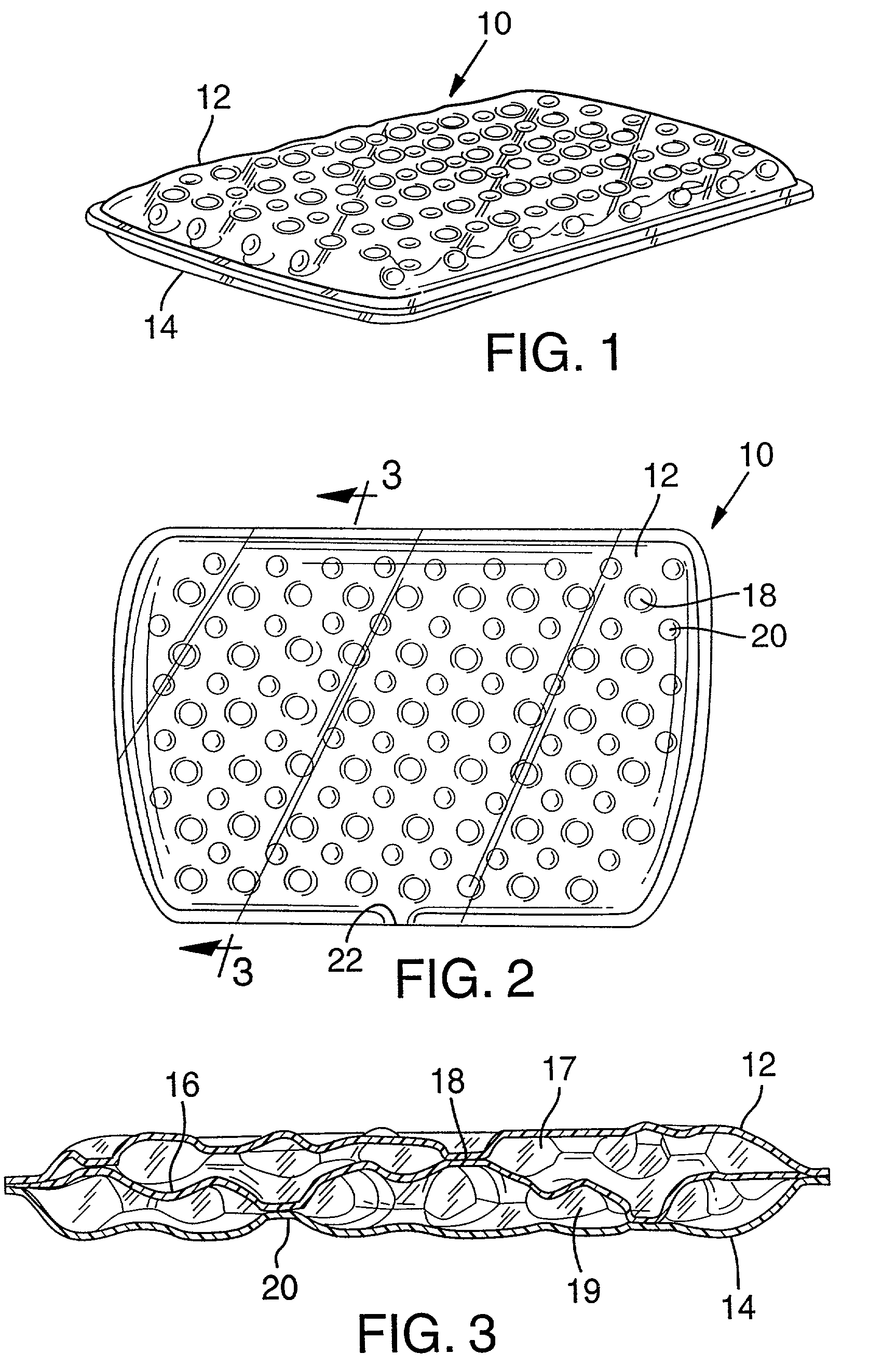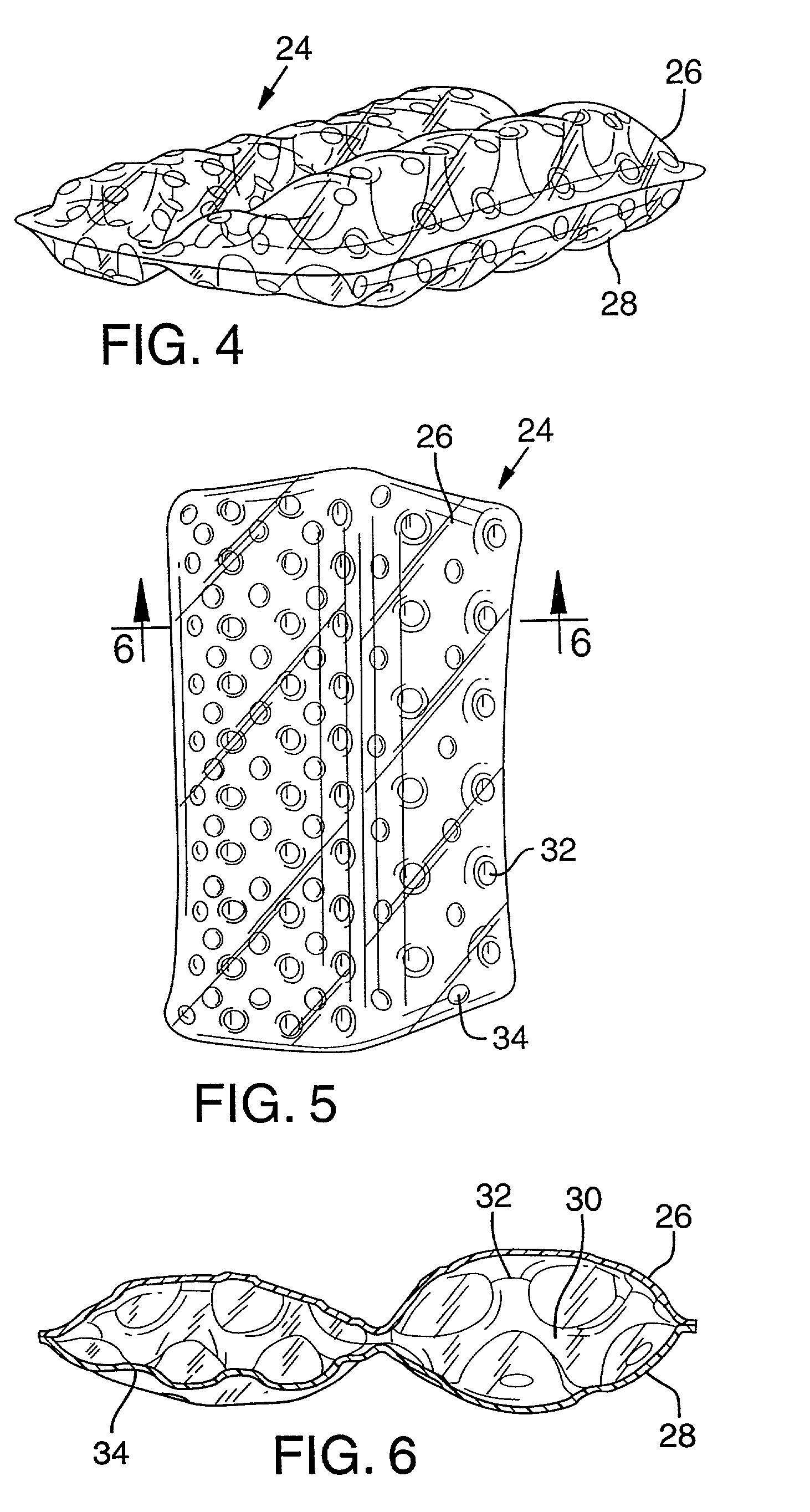Although with recent developments in materials and manufacturing methods, fluid filled bladders have greatly improved in versatility, there remain problems associated with obtaining optimum cushioning performance and durability.
While EVA foam can easily be
cut into desired shapes and contours, its cushioning characteristics are limited.
The major
engineering problems associated with the design of air bladders formed of barrier layers include: (I) obtaining complex-curved, contoured shapes without the formation of deep peaks and valleys in the cross section which require
filling in or moderating with foams or plates; (ii) ensuring that the means employed to give the air bladder its complex-curved, contoured shape does not significantly compromise the cushioning benefits of air; (iii) providing regionalized cushioning to an air bladder to account for differences in load corresponding to the anatomical topology of a human foot especially during high loads; (iv) designing air bladders which maximize the cushioning properties of air and are made entirely of flat barrier films; and (v) designing bladders that provide the advantages of complex-contoured shapes and regionalized cushioning and which can be integrated easily into existing midsole manufacturing methods.
The prior art is replete with attempts to address these difficulties, but have only solved one, two or even three of the above-described problems often presenting new obstacles in the process.
However, bladders with foam core tensile member have the
disadvantage of unreliable bonding of the core to the barrier layers.
Another
disadvantage of foam core bladders is that the foam core gives the bladder its shape and thus must necessarily function as a cushioning member which detracts from the superior cushioning properties of a gas alone.
Consequently, the reduction in the amount of gas in the bladder decreases the effectiveness of gas cushioning.
Even if a lower density foam is used, a significant amount of
available volume is sacrificed which means that the deflection height of the bladder is reduced due to the presence of the foam, thus accelerating the effect of “bottoming out.” Bottoming out refers to the
premature failure of a cushioning device to adequately decelerate an
impact load.
Bottoming out is the point where the cushioning
system is unable to compress any further and is a common failure in shoe soles comprised of foam.
The walls of individual cells constituting the foam structure abrade and tear as they move against one another and fail.
The breakdown of the foam exposes the wearer to greater shock forces.
One shortcoming of these bladders is that currently there is no known manufacturing method for making complex-curved, contoured shaped bladders using these fabric
fiber tensile members.
Another
disadvantage of fabric tensile members is the possibility of bottoming out.
Although the fabric fibers easily deflect under load and are individually quite small, the sheer number of them necessary to maintain the shape of the bladder means that under high loads, a significant amount of the total deflection capability of the air bladder is reduced by the volume of fibers inside the bladder and the bladder can bottom out.
One of the primary problems experienced with the fabric fibers is that these bladders are initially stiffer during initial loading than conventional gas filled bladders.
Further, no means are provided to cause the columns to flex in a predetermined fashion which would reduce fatigue failures.
Huang's columns are also prone to fatigue failure due to compression loads which force the columns to buckle and fold unpredictably.
Another disadvantage of Reed is that because the third, middle sheet is attached with connection lines that extend across the entire width of the insole, all the chambers formed are independent of one another and must be inflated individually which is impractical for
mass production.
The main disadvantage of this construction is that the ribs are vertically oriented and similar to the columns described in the patents to Huang and Moumdjian, would
resist compression and interfere with and decrease the cushioning benefits of air.
There is, however, no provision for multiple layers of fluid in the bladder which could be inflated to different pressures providing improved cushioning characteristics and point of purchase feel.
Individual bladder components cannot be customized.
Unnecessarily thick top and bottom layers can detract from the overall flexibility of the bladder.
Conversely, if certain portions of the bladder, such as the top and bottom surfaces, needed to be made of a thicker material relative to the transparent sidewalls, the transparency and / or flexibility of the sidewalls may be compromised.
Preparing a bladder for being exposed along the length of a sole window can also include expensive and
time consuming manufacturing steps.
The manufacturing steps taken to reduce the seam line increase the manufacturing time and cost of producing a bladder.
This simple profile seeks to balance the low-load-high-load criteria by a compromise to both since a simple cushioning profile provides generally uniform shock absorption and
response characteristics along the entire device, but does not provide a complex cushioning profile which can be customized or regionalized to the loads realized at certain points along a bladder.
A problem with manufacturing complex, highly regionalized bladders of two films has been inordinate twisting of the fluid filled part.
A non-planar geometry is difficult to integrate into subsequent shoe making processes.
As discussed above, while the prior art has addressed some of these problems, they each have their disadvantages and fall short of a complete solution.
 Login to View More
Login to View More 


